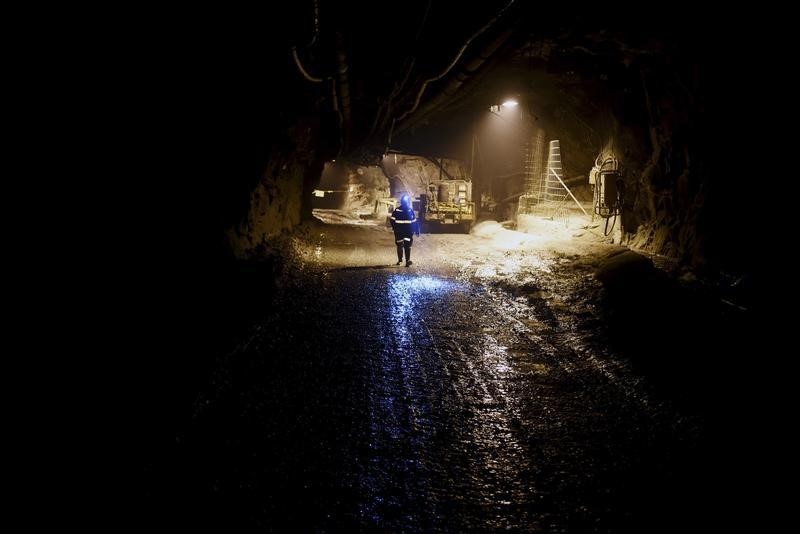By Julia Symmes Cobb and Susan Taylor
COSCUEZ, Colombia/TORONTO, Dec 12 (Reuters) - A tiny company is trying to breathe new life into a fabled, four-century-old Colombian emerald mine without triggering unrest among wary locals who fear being shut out of the tunnels where they hunt for gems and make a meager living.
Fura Gems FURA.V , the first listed emerald miner to operate in Colombia, has $10 million invested to date. The company, based in Dubai and listed in Canada, faces a community relations test as it tries to rehabilitate Coscuez, the country's top producer until sometime after 1998, as declining investment and outdated mining methods eroded output.
For decades, residents have scoured the dozens of tunnels crisscrossing Coscuez for stones to buy their next meal. Locals say there are hundreds of people digging daily.
Fura has pledged to gradually phase out access to the shafts while helping locals find alternative employment like baking, sewing and poultry farming. The company hopes this will help prevent security problems like those that hit a mine in nearby Muzo, known as the world's emerald capital.
But many locals are skeptical.
"People here won't stand for what happened in Muzo," said Beatrice Sanabria, 57, after a long day of "informal" mining at Fura's Coscuez, high in the Andes.
"Up to now, thank God, they've let us work," said the mother of five. She spoke one October afternoon as dozens of other informal miners, dirty and weary after a hard day of digging, rinsed their muddy hauls outside the narrow tunnel, searching for a telltale green glint. Several Fura security guards stood nearby.
Today, Colombia produces less than 25 percent of global emerald supply, but that represents about 50 percent of value, said Panmure Gordon mining analyst Kieron Hodgson. Colombian emeralds can demand a premium because of their high quality.
For the decade leading up to 2005, Colombia accounted for 47 percent of global emerald output, but that declined due to factors ranging from a lack of new discoveries to global oversupply.
"The real opportunity for Colombian emeralds is regaining its previous standing in the global value chain," Hodgson said, adding 2016-17 output was 2.4 million carats, down from 10 million carats in the early 2000s. Global demand has grown "significantly" over the last decade, he added.
Fura, formed by former executives at Gemfields Group GMLJ.J , the world's largest ruby and emerald producer, aims to change that. Dev Shetty, ex-Gemfields COO and now Fura CEO, said he wanted to continue developing Coscuez after Gemfields withdrew last year to focus on Africa.
While Fura's gradual approach to cutting off tunnel access may ward off violent raids like those that hit rival Mineria Texas Colombia (MTC), the jury is still out on the long-term prospects for the company and Coscuez.
Informal mining is a pervasive challenge in the gemstone sector, said Sebastian Sahla, of the Natural Resource Governance Institute, a non-profit focused on oil and mining, adding he has not analyzed Fura.
Alternative employment often falters because informal mining is more lucrative, he said, while confrontational approaches typically fail because they can sour community relations.
At the same time, the practice carries high risks.
"If you are a listed company and a tunnel on your license with dozens of (informal) miners inside collapses, and they all die, that's not great," he said.
DOORS BLOWN OFF
Still, Fura's Shetty says it is impractical to shutter all tunnels at once.
"We're not allowing informal mining to officially take place, but practically things take time," he said. "We can't police the whole mountain."
Fura has shut four of 49 tunnels, Shetty said, but has not set a schedule to close the rest.
More than 96 percent of Fura's 270 employees are from Coscuez, said Shetty, adding it eventually plans to employ at least 400 at the mine.
The company, which is also developing ruby projects in Mozambique, expects to become profitable in late 2020.
The region has seen mining-related violence in the past.
In 2015, armed bandits attacked MTC's Muzo mine, using explosives to blow off a tunnel's steel doors and shooting at workers.
MTC made unspecified changes to security after that invasion and another one in 2013 and attributes both attacks to local crime gangs.
Later, locals were upset when MTC complied with environmental regulations and stopped dumping mine debris in the river, depriving them of another source of gems.
MTC formally hired most of Muzo's previously unsalaried miners, but some have resisted change, said director Charles Burgess.
"They did not want a formal, paid job mining. They wanted unfettered access to the mine so they could steal," he said.
With MTC now in control of mine output, emerald dealers from Muzo regularly make the 90-minute trip over rugged mountain roads to reach Coscuez, buying under-the-table, tax-free stones.
While a rare few strike it rich, most are lucky to make enough to survive and many say there are no other options beyond working the tunnels, where temperatures can reach 50 degrees Celsius (122 degrees Fahrenheit).
And locals like Francisco Cordoba, 55, worry that sooner or later, their livelihood will be cut off.
"People worry this will become Muzo," he said. "That a time will come when they say 'No more.'"
